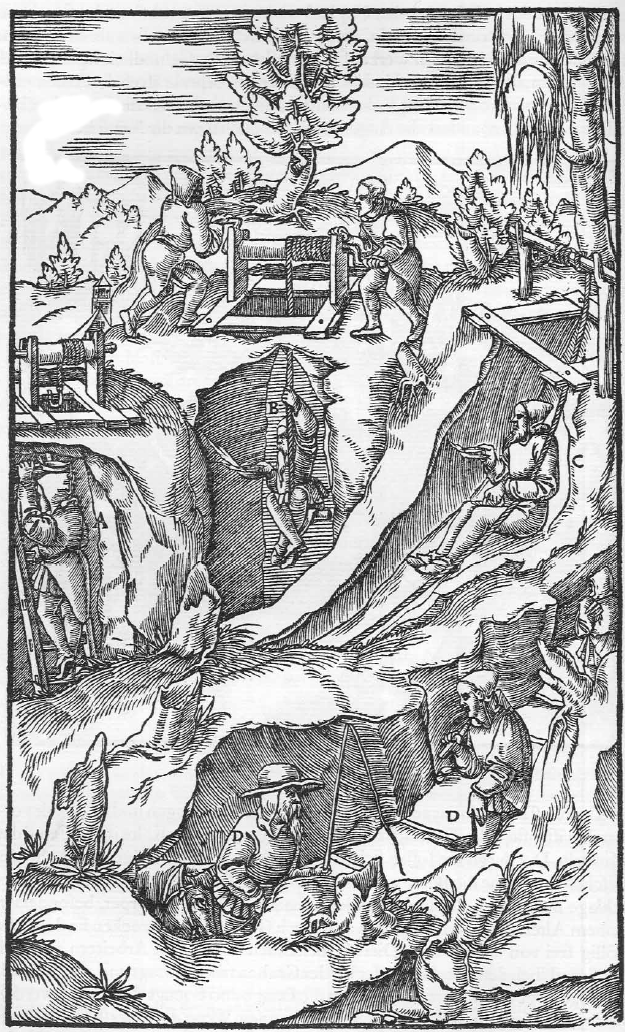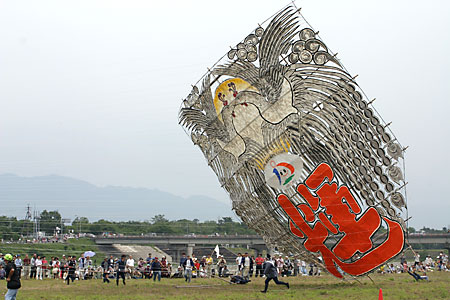|
Miner's Apron
The miner's apron (german: Arschleder, ''Bergleder'' or ''Fahrleder'') is part of the clothing worn, especially historically, by miners in the mining industries of German-speaking Europe. Variously called in English a miner's apron, a miner's after-apron, breech leatherBucksch, Herbert (1997). ''Dictionary Geotechnical Engineering'', Vol. 2, Springer, Berlin, Heidelberg, New York, p. 77, . or miner's leather apron,Pohs, Henry A. (1995). ''The miner's flame light book'', Flame Pub. Co., pp. 107 and 119. it was a leather apron that served to keep the seat of the trousers from wearing out when working or moving around the mine (''Fahrung'') as well as keeping out the cold and moisture when sitting. It also provided protection especially when entering inclined mineshafts. Another advantage was that it stabilised the internal organs from mechanical shock and vibration by acting as a sort of kidney belt. The miner's apron was a triangular or, more rarely, semi-circular piece of lea ... [...More Info...] [...Related Items...] OR: [Wikipedia] [Google] [Baidu] |
Smoking Figurine
Smoking is a practice in which a substance is burned and the resulting smoke is typically breathed in to be tasted and absorbed into the bloodstream. Most commonly, the substance used is the dried leaves of the tobacco plant, which have been rolled into a small rectangle of rolling paper to create a small, round cylinder called a cigarette. Smoking is primarily practised as a route of administration for recreational drug use because the combustion of the dried plant leaves vaporizes and delivers active substances into the lungs where they are rapidly absorbed into the bloodstream and reach bodily tissue. In the case of cigarette smoking, these substances are contained in a mixture of aerosol particles and gases and include the pharmacologically active alkaloid nicotine; the vaporization creates heated aerosol and gas into a form that allows inhalation and deep penetration into the lungs where absorption into the bloodstream of the active substances occurs. In some cultures, s ... [...More Info...] [...Related Items...] OR: [Wikipedia] [Google] [Baidu] |
History Of Mining
Mining is the extraction of valuable minerals or other geological materials from the Earth, usually from an ore body, lode, vein, seam, reef, or placer deposit. The exploitation of these deposits for raw material is based on the economic viability of investing in the equipment, labor, and energy required to extract, refine and transport the materials found at the mine to manufacturers who can use the material. Ores recovered by mining include metals, coal, oil shale, gemstones, limestone, chalk, dimension stone, rock salt, potash, gravel, and clay. Mining is required to obtain most materials that cannot be grown through agricultural processes, or feasibly created artificially in a laboratory or factory. Mining in a wider sense includes extraction of any non-renewable resource such as petroleum, natural gas, or even water. Modern mining processes involve prospecting for ore bodies, analysis of the profit potential of a proposed mine, extraction of the desired materials, and f ... [...More Info...] [...Related Items...] OR: [Wikipedia] [Google] [Baidu] |
Mooskappe
The ''Mooskappe'' is an old, traditional miners head covering. It was intended to protect miners when working underground from the impact of small rockfalls and from hitting their heads against the gallery roof (''Firste''). The term is German and this type of hat was worn especially in the Harz Mountains of Germany. It is known that the ''Mooskappe'' was definitely used in the Harz and Barsinghausen mining regions. It appears in steel engravings from about 1850, for example by Wilhelm Ripe, as an important item of safety gear. In 1824 Heinrich Heine visited the ''Caroline'' and ''Dorothea'' mines at Clausthal, writing about these visits in various works. About the miner's uniforms he says: The ''Mooskappe'' was usually made of a hard, green felt, but there were also "crocheted" (''gehäkelte'') designs. The shape is either clearly cylindrical but it can also be dome-shaped. See also *Miner's cap *Miner's habit References Caps History of mining in Germany Miners' ... [...More Info...] [...Related Items...] OR: [Wikipedia] [Google] [Baidu] |
Miner's Cap
The miner's cap (german: Fahrhaube) is part of the traditional miner's costume. It consists of a white material (linen) and served in the Middle Ages to protect the miner when descending below ground (''unter Tage''). Later it was replaced by the miner's hat (''Fahrhut'' or ''Schachthut''), from which the leather cap or helmet were developed and subsequently today's mining helmets. See also * Miner's habit *'' Mooskappe'' - miner's cap from the Harz Mountains The Harz () is a highland area in northern Germany. It has the highest elevations for that region, and its rugged terrain extends across parts of Lower Saxony, Saxony-Anhalt, and Thuringia. The name ''Harz'' derives from the Middle High German ... Literature * Caps Miners' clothing {{mining-stub ... [...More Info...] [...Related Items...] OR: [Wikipedia] [Google] [Baidu] |
Miner's Habit
A miner's habit (german: Berghabit or ''Bergmannshabit'') is the traditional dress of miners in Europe. The actual form varies depending on the region, the actual mining function, and whether it is used for work or for ceremonial occasions. Elements At work, the miner of the Middle Ages in Europe wore the normal costume for his local region – pit trousers (''Grubenhose''), shoes and miner's jacket (''Bergkittel''). Only gradually was the typical miner's uniform created by the addition of unmistakable elements of miner's apparel such as the miner's apron (''Arschleder''), knee pads (''Kniebügel''), miner's cap (''Fahrhaube'' or ''Fahrkappe'', later pit hat (''Schachthut''), the mining tools needed for work in the pit, such as hammers (''Fäustel''), chisels (''Eisen''), wedges, picks (''Keilhauen''), hoes (''Kratze''), shovels, crowbars, pikes (''Brechstangen'') or miner's chisels (''Bergeisen''), mallets (''Schlägel'') or carpenter's hatchets, the miners' safety lamps ... [...More Info...] [...Related Items...] OR: [Wikipedia] [Google] [Baidu] |
Kite Surfing
Kiteboarding or kitesurfing is a sport that involves using wind power with a large power kite to pull a rider across a water, land, or snow surface. It combines aspects of paragliding, surfing, windsurfing, skateboarding, snowboarding, and wakeboarding. Kiteboarding is among the less expensive and the more convenient sailing sports. After some concepts emerged in the late 1970s and early 1980s and some designs were successfully tested, the sport received a wider audience in the late 1990s and became mainstream at the turn of the century. It has freestyle, wave-riding, and racing competitions. The sport held the speed sailing record, reaching before being eclipsed by the Vestas Sailrocket. Worldwide, there are 1.5 million kitesurfers, while the industry sells around 100,000 to 150,000 kites per year. Most power kites are leading edge inflatable kites or foil kites attached by about of flying lines to a control bar and a harness. The kitesurfer rides on either a bidir ... [...More Info...] [...Related Items...] OR: [Wikipedia] [Google] [Baidu] |
Power Kiting
A power kite or traction kite is a large kite designed to provide significant pull to the user. Types The two most common forms are the foil kite, foil, and the leading edge inflatable kite, leading edge inflatable. There are also other less common types of power kite including rigid-framed power kite, rigid-framed kites and soft single skin kites. There are several different kite control systems, control systems used with these kites which have two to five lines and a bar or handles. Foil kites consist of a number of cells with cloth ribs in each cell. It is the profile of these ribs that gives the kite its aerofoil shape and enable it to generate lift. The most common type is the ram-air foil, where each cell has a gauze-covered opening at the front, meaning air is forced in during flight, giving the kite its stiffness and enabling it to hold its profile. Some ram-air foils are closed-cell, where a one-way valve locks the air inside the cells, giving some increased water rela ... [...More Info...] [...Related Items...] OR: [Wikipedia] [Google] [Baidu] |
Kite
A kite is a tethered heavier than air flight, heavier-than-air or lighter-than-air craft with wing surfaces that react against the air to create Lift (force), lift and Drag (physics), drag forces. A kite consists of wings, tethers and anchors. Kites often have a bridle and tail to guide the face of the kite so the wind can lift it. Some kite designs don’t need a bridle; box kites can have a single attachment point. A kite may have fixed or moving anchors that can balance the kite. The name is derived from kite (bird), kite, the hovering bird of prey. The Lift (force), lift that sustains the kite in flight is generated when air moves around the kite's surface, producing low pressure above and high pressure below the wings. The interaction with the wind also generates horizontal Drag (physics), drag along the direction of the wind. The resultant force vector from the lift and drag force components is opposed by the tension of one or more of the rope, lines or tethers to which t ... [...More Info...] [...Related Items...] OR: [Wikipedia] [Google] [Baidu] |
Schnaps
Schnapps ( or ) or schnaps is a type of alcoholic beverage that may take several forms, including distilled fruit brandies, herbal liqueurs, infusions, and "flavored liqueurs" made by adding fruit syrups, spices, or artificial flavorings to neutral grain spirits. The English loanword "schnapps" is derived from the colloquial German word ''Schnaps'' (plural: ''Schnäpse''), which is used in reference to spirit drinks. The word ''Schnaps'' stems from Low German and is related to the German term "''schnappen''", meaning "snap", which refers to the spirit usually being consumed in a quick slug from a small glass (i.e., a shot glass). European The German term ''Schnaps'' refers to "any kind of strong, dry spirit", similar to how ''eau de vie'' (water of life) is used in French, ''aguardiente'' (burning water) in Spanish, or ''aguardente'' Portuguese. ''Obstler'' ''Obstler'', or ''Obstbrand'' (from the German ''Obst'', fruit), are a traditional type of schnaps made by fermentin ... [...More Info...] [...Related Items...] OR: [Wikipedia] [Google] [Baidu] |
Saarland
The Saarland (, ; french: Sarre ) is a state of Germany in the south west of the country. With an area of and population of 990,509 in 2018, it is the smallest German state in area apart from the city-states of Berlin, Bremen, and Hamburg, and the smallest in population apart from Bremen. Saarbrücken is the state capital and largest city; other cities include Neunkirchen and Saarlouis. Saarland is mainly surrounded by the department of Moselle ( Grand Est) in France to the west and south and the neighboring state of Rhineland-Palatinate in Germany to the north and east; it also shares a small border about long with the canton of Remich in Luxembourg to the northwest. Saarland was established in 1920 after World War I as the Territory of the Saar Basin, occupied and governed by France under a League of Nations mandate. The heavily industrialized region was economically valuable, due to the wealth of its coal deposits and location on the border between France and German ... [...More Info...] [...Related Items...] OR: [Wikipedia] [Google] [Baidu] |

.jpg)






